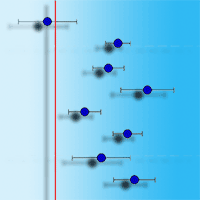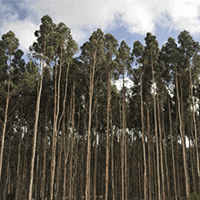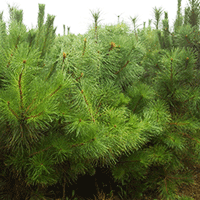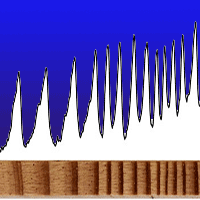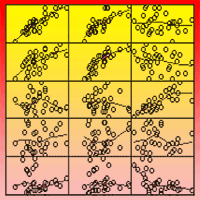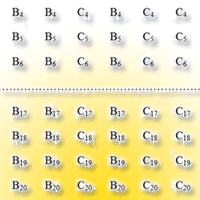
Nitrogen removal and its determinants in hybrid Populus clones for bioenergy plantations after two biennial rotations in two temperate sites in northern Italy
Pierluigi Paris (1), Leonardo Mareschi (2), Maurizio Sabatti (3), Luca Tosi (1-3), Giuseppe Scarascia-Mugnozza (3)
iForest - Biogeosciences and Forestry, Volume 8, Issue 5, Pages 668-676 (2015)
doi: https://doi.org/10.3832/ifor1254-007
Published: Feb 02, 2015 - Copyright © 2015 SISEF
Research Articles
Abstract
The sustainability of bioenergy coppice plantations is strongly affected by the Nitrogen (N) balance, whose removal is very high due to the frequent harvest of large quantities of biomass composed of small-sized shoots. Poplar bioenergy coppice plantations could have a Nitrogen removal comparable to herbaceous crops. In this study, five hybrid poplar genotypes (“AF2”, “AF6”, “Monviso”, “83.148.041”, “I214”) were compared for tree morphological traits related to yield, N removal in the harvested biomass and Nitrogen wood concentration (N%) after two biennial coppice rotations in two experimental plantations located in northern Italy. N removal was primarily influenced by biomass production, and linear positive relationships between biomass yield and N removal were established. N removal also varied greatly among genotypes due to clonal differences in yield and in N%, in relation to significant differences among clones for their branching and sprouting habits. In the first rotation, branchiness was positively correlated to N% with a significant coefficient of determination (R2=0.813), while at the end of the second rotation it was also significantly correlated to the shoots per stool ratio (R2=0.804). “Monviso” and “83.148.041” were the clones showing the highest yield, but also a high N% associated to an high level of branchiness and shoots per stool ratio. Our results highlight that poplar genotype selection for sustainable N management should be aimed at genotypes with low wood N concentration, coupling high yield with low branching and sprouting habits as in the case of the clone “AF2”.
Keywords
Branching Habit, Coppice Plantations, Fertilization, Growth Traits, Sprouting Habit
Authors’ Info
Authors’ address
Luca Tosi
C.N.R.- Istituto di Biologia Agroambientale e Forestale, v. G. Marconi 2, I-05010 Porano (TR - Italy)
Corpo Forestale dello Stato, v. A. Pacinotti 5, I-01100, Viterbo (Italy)
Luca Tosi
Giuseppe Scarascia-Mugnozza
Di.B.A.F.- Università degli Studi della Tuscia, v. S. Camillo de Lellis, I-01100 Viterbo (Italy)
Corresponding author
Paper Info
Citation
Paris P, Mareschi L, Sabatti M, Tosi L, Scarascia-Mugnozza G (2015). Nitrogen removal and its determinants in hybrid Populus clones for bioenergy plantations after two biennial rotations in two temperate sites in northern Italy. iForest 8: 668-676. - doi: 10.3832/ifor1254-007
Academic Editor
Gianfranco Minotta
Paper history
Received: Jan 28, 2014
Accepted: Oct 30, 2014
First online: Feb 02, 2015
Publication Date: Oct 01, 2015
Publication Time: 3.17 months
Copyright Information
© SISEF - The Italian Society of Silviculture and Forest Ecology 2015
Open Access
This article is distributed under the terms of the Creative Commons Attribution-Non Commercial 4.0 International (https://creativecommons.org/licenses/by-nc/4.0/), which permits unrestricted use, distribution, and reproduction in any medium, provided you give appropriate credit to the original author(s) and the source, provide a link to the Creative Commons license, and indicate if changes were made.
Web Metrics
Breakdown by View Type
Article Usage
Total Article Views: 54724
(from publication date up to now)
Breakdown by View Type
HTML Page Views: 46270
Abstract Page Views: 3291
PDF Downloads: 3661
Citation/Reference Downloads: 29
XML Downloads: 1473
Web Metrics
Days since publication: 4005
Overall contacts: 54724
Avg. contacts per week: 95.65
Citation Metrics
Article Citations
Article citations are based on data periodically collected from the Clarivate Web of Science web site
(last update: Mar 2025)
Total number of cites (since 2015): 11
Average cites per year: 1.00
Publication Metrics
by Dimensions ©
Articles citing this article
List of the papers citing this article based on CrossRef Cited-by.
References
Bioenergy. In: “IPCC Special Report on Renewable Energy Sources and Climate Change Mitigation” (Edenhofer O, Pichs-Madruga R, Sokona Y, Seyboth K, Kadner S, Zwickel T, Eicjmeier P, Hansen G, Schlomer S, Von Stechow C, Matschoss P eds). Cambridge University Press, Cambridge, United Kingdom and New York, NY, USA, pp. 1075
CrossRef | Gscholar
Il pioppo dà più biomassa con turno biennale ed irrigato [Enhanced biomass yield of poplar SRC under 2-year rotation cycle with irrigation]. L’Informatore Agrario 32: 27-29. [in Italian]
Gscholar
Short-rotation plantations of balsam poplars, aspen and willows on former arable land in the Federal Republic of Germany. II. Nutritional status and bioelement export by harvested shoot axes. Forest Ecology and Management 121 (1-2): 67-83.
CrossRef | Gscholar
Nachwachsende Energietrager - Grundlagen, Verfahren, Ökologische Bilanzierung [Biofuels: Basics, processes, ecological balances]. Vieweg, Braunschweig, Wiesbaden, Germany, pp. 527. [in German]
Gscholar
Le nuove varietà di pioppo da biomassa garantiscono produttività interessanti [The new poplar varieties for bioenergy guarantee attractive productivity]. L’Informatore Agrario 18: 49-53. [in Italian]
Gscholar
Indagini su cedui di pioppo a turno breve nella pianura ferrarese [Researches on Short Rotation Forestry with poplar in the South-Eastern part of the Po Valley (Italy)]. L’Italia Forestale e Montana 5/6: 411-419. [in Italian]
Gscholar
Asportazioni di azoto con la raccolta di biomassa [Removal of Nitrogen with biomass harvesting in poplar SRC plantations]. Linea Ecologica 4: 2-8. [in Italian]
Gscholar
Production physiology and morphology of Populus species and their hybrids grown under short rotation. II. Biomass components and harvest index of hybrid and parental species clones. Canadian Journal of Forest Research 27 (3): 285-294.
CrossRef | Gscholar

